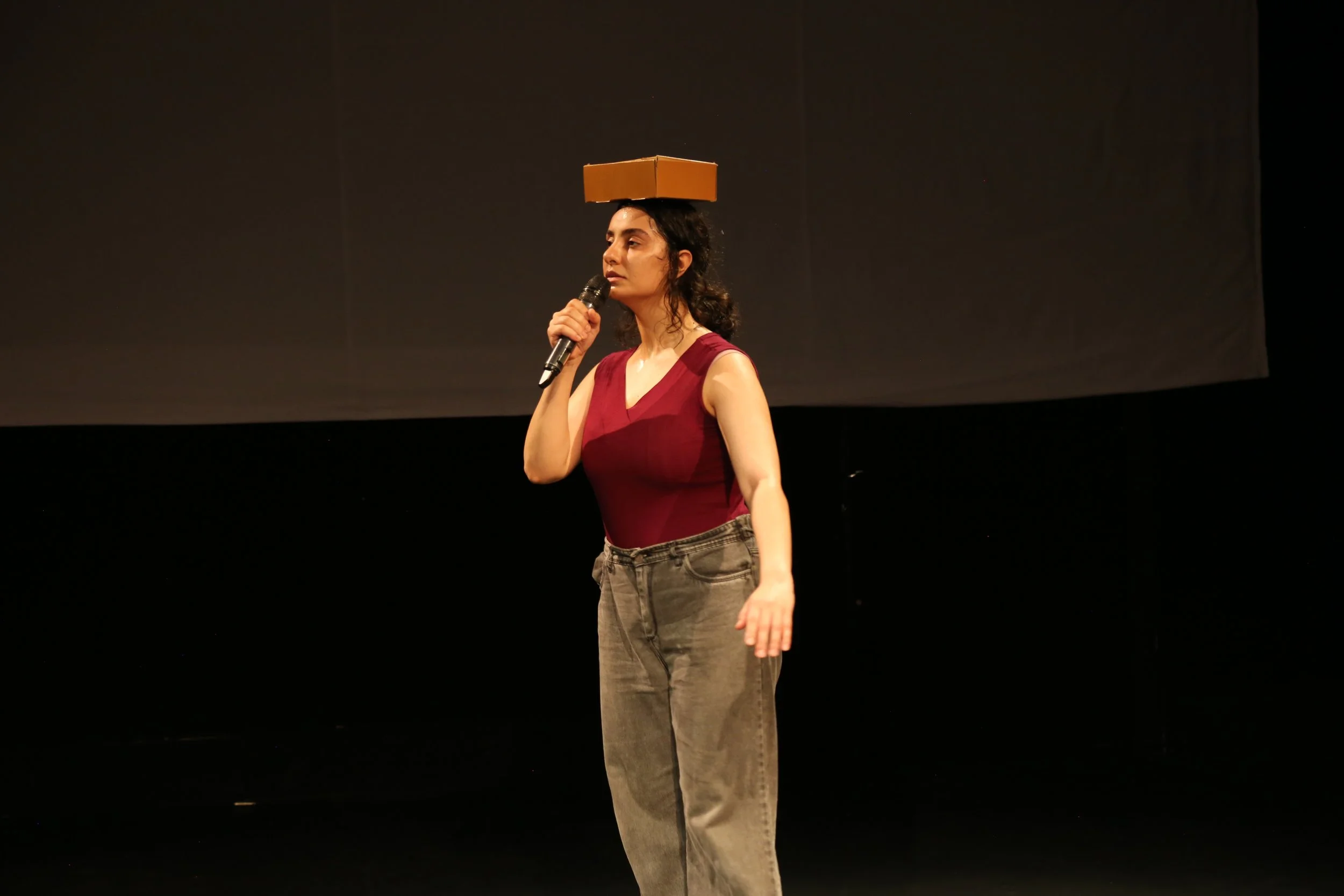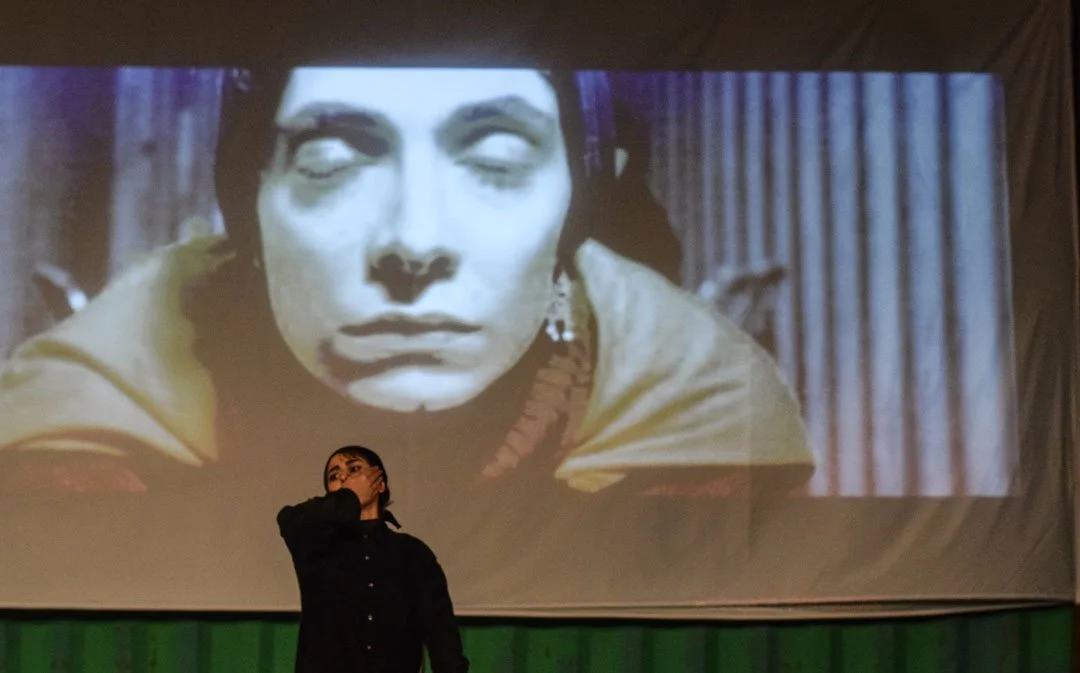Headless, how can I sing?
by Tree Theater Group
Dramaturgy: Sara Karimi
This performance began with a significant statement: "Don't look back!"
This statement, which turned Lot's wife into stone and forever separated Eurydice from Orpheus, is a powerful reminder that anyone contemplating immigration must define their relationship with it. On stage, the performers engage in a reevaluation of their connections to home, their roles as performers, the concept of love, and the idea of immigration. Simultaneously, Lot's wife, Orpheus and Eurydice, Hades (the god of the underground performance), and a contemporary dancer struggling with political protests in Iran, come to life on stage. In the form of devised theatre, we intermingled two distinct forms of storytelling: The timeless myths of love and migration (Orpheus and Eurydice and Lot's Wife Story) and personal narratives of performers, including their experiences during "Woman, Life, Freedom" movement. The final performance is shaped by a fluid dramaturgy, emerging from the performer's improvisations during rehearsals and the writer's assemblage. At the heart of our creative process lies the profound transformation of narratives, as we bridge the gap between their mythological origins and their resonance with the contemporary issue of immigration.
Hamletmachine
by Heiner Muller
Firstly performed in January 2018, at Nofel Loshato Theater in Tehran, "Hamletmachine" is interwoven with Shakespeare's Hamlet, and our profound endeavor to contemplate the theme of 'death' and its profound impact on the living. Our central theme, 'death,' serves as the nexus linking Shakespeare's Hamlet and the ethereal atmosphere of a 'dead body.' As we meticulously crafted the dramaturgy of our production, two pivotal issues came to the forefront: the juxtaposition of majority-minority social groups and the spirit of rebellion. In this theatrical piece, our gaze was firmly fixed on the minority, with a keen focus on the plight of women. In our homeland, discrimination against women is an ever-present reality, permeating every facet of their lives. Here, within the narrative of "Hamletmachine," we discern this confrontation in the power dynamics between the protagonist and Ophelia's narrative. We believe the essence of rebellion finds its home in the realm of women. As Ophelia, portrayed by a talented actress, took center stage, her actions spoke volumes. She submerged the scene in her blood, grappled with addiction to cocaine, and culminated the show by enveloping the space in the tactile sound of a rubbing microphone against her body. In these poignant moments, our ensemble sought to unearth the intricate realities of women in contemporary Iran, primarily through Ophelia's eloquent non-verbal expression. Here, you will witness a multifaceted exploration of life, death, rebellion, and the silent struggles of women, all interwoven into a compelling tapestry of theater and storytelling. This piece serves as a testament to the power of the stage in shedding light on the intricate nuances of our society, resonating with those who possess a deep understanding of the complex interplay of these themes.
3 Ten-Minutes
Sculptures
Performance | 3 hours a day
Drawing inspiration from Erwin Wurm's One-Minute Sculptures, I embarked on a study centered on objects that transform into time-based sculptures, ultimately leading to a nuanced exploration of political, social, and cultural dynamics. These objects, employed during their moment of application, serve as temporary solutions and offer an unconventional take on the human form. My choice fell upon a Box/Stage, meticulously applied to the human body, serving as a symbolic reference to the "Telecommunication Post" located at the "Vesal-Enqelab crossroad." This particular post carries historical significance, having witnessed and chronicled the women's protests in Iran. To provide context, the measurements for this specific Post stand at 43x117x143 cm. Upon this Box/Stage/Post, a figure stands on the precipice of speech, scream, or protest—a threshold of expression. The performers, positioned with a microphone at the boundary of their lips, breathe deeply. In this powerful moment, silence prevails; there are no spoken words, no speeches. Instead, the sound emanates with unwavering strength, resonating with profound significance. This exploration transcends into a contemplation of the charged sociopolitical and cultural undercurrents, inviting perceptive viewers to reflect on the essence of human expression and the resonance of silence.
Oresteia 2
by Aeschylus
Dramaturgy: Maryam Zeraatkar
"Oresteia, recognized for its unflinching portrayal of violence within the familial context, stands as one of the most intense theatrical productions in history. Against the backdrop of Iran's tumultuous situation, particularly during and after the pandemic, a disturbing surge in domestic violence, with a tragic focus on femicides, became increasingly prevalent. In response, 'Oresteia 2' embarked on a profound exploration of family dynamics and domestic violence, drawing from documented narratives in Iranian newspapers. This endeavor sought to craft a novel rendition of Oresteia while maintaining a thought-provoking intertextuality with Aeschylus's text. 'Oresteia 2' earned a prestigious invitation to the Mokhtas Experimental Theater Festival, hosted in the maritime city of Genaveh in Bushehr. Amidst the backdrop of shipping container depots at the port, we delivered three impactful performances, with approximately 80 individuals in the audience each night. This adaptation of 'Oresteia' serves as a powerful reflection of the harsh realities of domestic violence and femicide in Iran, intertwining contemporary narratives with classical Greek tragedy.
Mother Theatre
and her Children
Walk / Performance
This is an audio-walk selected work in Iran’s International University Theater that was awarded and appreciated in site-specific performances. This off-stage performance was an attempt to find a new way to involve the audience through a performance using an assembly of sound narratives on the site. There were 3 sound narratives, consisting of two story-telling narratives and one that recorded a verbatim conversation between two theater students about theater and immigration. Indeed, all these three narratives were about Theatre. A performer in the first location (City Theatre parking lot) starts a chain of accompanying spectators and listeners to reach location number 2. Another performer does the same for the short journey from location number 2 to 3. Every ten minutes new spectators by a group of 2 or 3 persons could arrive at the performance and start from location No.1.



